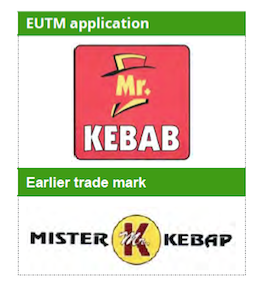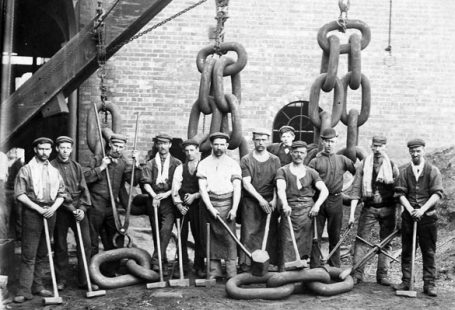Mr Kebab and Mister Kebap
The GC endorsed the BoA’s findings that the signs in question were similar. It stated that the global assessment of the likelihood of confusion, in relation to the visual, aural or conceptual similarity of the marks, must be based on the overall impression given by the marks while taking into account their distinctive and dominant components (para. 20). The GC considered that in the case in question the dominant elements of both signs were ‘Mr. Kebab’ and ‘Mister Kebap’ and at the same time found that these elements were distinctive (para. 29).
The GC confirmed the BoA findings that the figurative elements of the contested sign emphasised the meaning of its word elements and as such were descriptive. Furthermore, it stated that the figurative elements in both signs were not very striking (para. 41). The signs were found to be visually similar and aurally similar to a very high degree. Moreover, the signs were found almost identical from the conceptual point of view for a part of the relevant public, whereas the signs could not have been compared from the conceptual perspective in relation to the part of the relevant public that would not understand their verbal elements (paras 42-46). Therefore, the GC concluded that there was a likelihood of confusion between the trade marks in question (paras 47- 49).
 It furthermore emphasised that although the distinctive character of the earlier trade mark must be taken into account when assessing the likelihood of confusion, it was only one factor among others involved in that assessment. It also stated that the applicant’s arguments regarding the distinctive character of the earlier trade mark would have the effect of disregarding the notion of the similarity of the marks in favour of one based on the distinctive character of the earlier mark, which would then be given undue importance. The result would be that, where the earlier mark was only of weak distinctive character, a likelihood of confusion would exist only where there was a complete reproduction of that mark by the mark applied for, whatever the degree of similarity between the marks in question. Such a result would not, however, be consistent with the very nature of the global appreciation that the competent authorities are required to undertake by virtue of Article 8(1)(b) EUTMR (paras 51-52).
It furthermore emphasised that although the distinctive character of the earlier trade mark must be taken into account when assessing the likelihood of confusion, it was only one factor among others involved in that assessment. It also stated that the applicant’s arguments regarding the distinctive character of the earlier trade mark would have the effect of disregarding the notion of the similarity of the marks in favour of one based on the distinctive character of the earlier mark, which would then be given undue importance. The result would be that, where the earlier mark was only of weak distinctive character, a likelihood of confusion would exist only where there was a complete reproduction of that mark by the mark applied for, whatever the degree of similarity between the marks in question. Such a result would not, however, be consistent with the very nature of the global appreciation that the competent authorities are required to undertake by virtue of Article 8(1)(b) EUTMR (paras 51-52).
Dandi Law Firm provides legal assistance in several Practice Areas. Check out our Services or contact Us!






